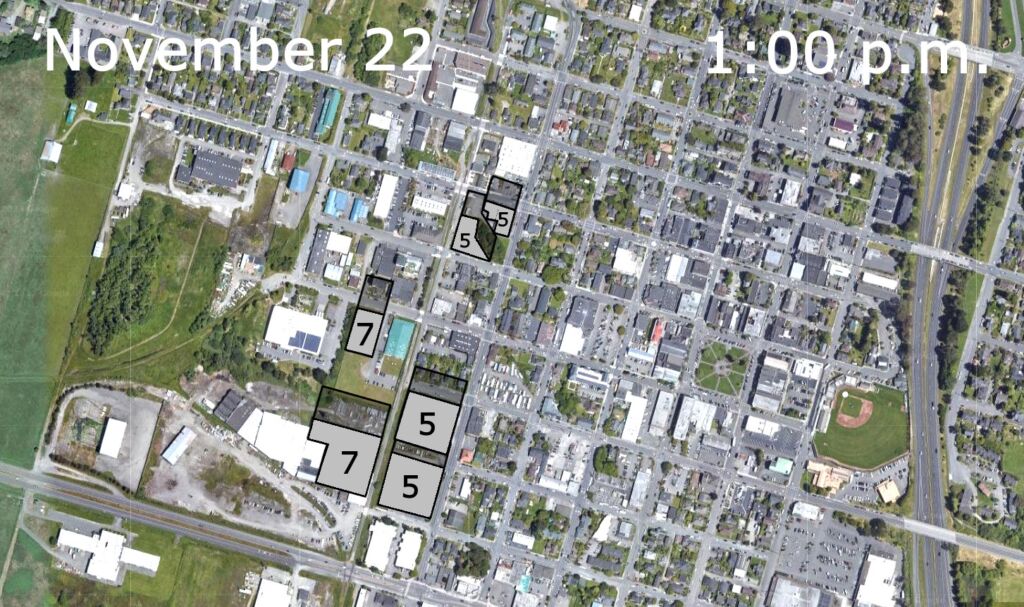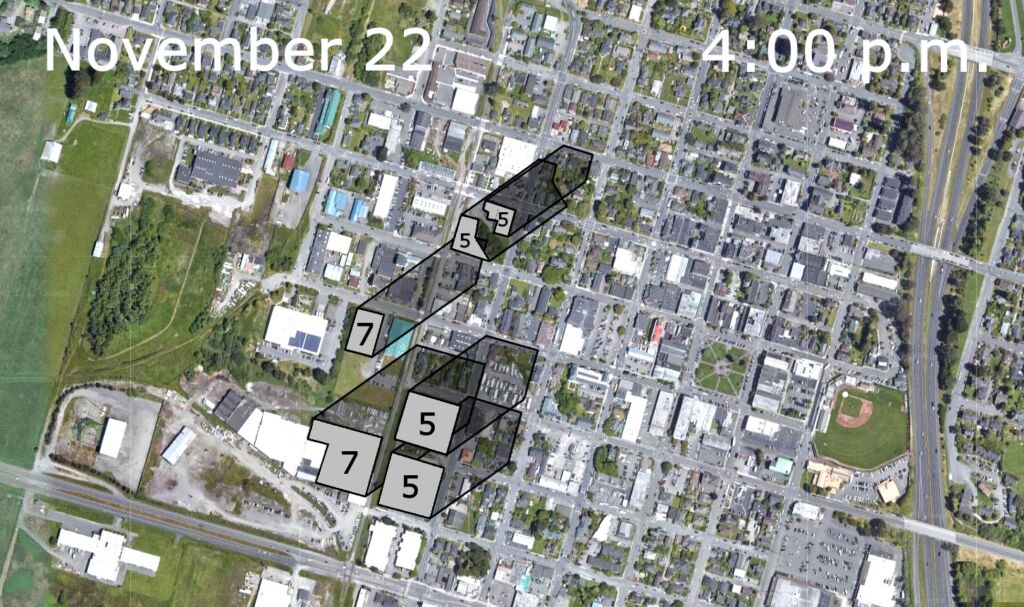This article contains three brief videos — two are 35 seconds and one is 28 seconds. You may want to read the entire article, but if you just want to watch the shadowing videos, they’re at: November 22, October 22, and Devlin Cottages.
Contents Use your browser’s back-arrow to return to these contents
- The situation
- How to watch the Solar Shading videos
- The Videos
November 22 and October 22
Solar Shading on the Devlin Cottages
Solar Shading on the L Street Corridor Linear Park -
Orientation – To help locate familiar buildings and locations.
- The “Buildings” used in these Solar Shading images
- Background – The City’s solar shading images are inadequate
- Solar Shading on November 22nd – Individual images
-
“Solar Shading Impacts 3D GIS Analysis” – Arcata Community Development Department official video
The situation
For two months of the year in Arcata, at a half-hour before sunset, a building that is 80 feet tall — a 7-story building, as allowed in the Gateway Code for the Barrel district — will cast a shadow that is 1,150 feet long or greater — close to four Arcata blocks. A 5-story building, 60 feet tall, casts a 860 foot long shadow, almost three Arcata blocks.
For four months of the year — for one-third of the year — at a half-hour before sunset, a 7-story building will cast a shadow that almost 1,000 feet long or greater. A 5-story building casts a 750 foot long shadow or greater.
How to watch the Solar Shading videos
Each video is about 35 seconds long. Each has 11 images shown for 3 seconds, with the last image held a little longer. If left alone, the brief video will loop back to the start and repeat.
The Play triangle button will start the video, and the Pause button will stop it at any point if you want to look at a specific shadowing image. To see the video larger and with more detail, press the Full-Screen button at the lower right — that will expand the video to be the larger size of your screen. (The bottom row of buttons will disappear… If that button isn’t there, just put your cursor on the video and it will re-appear.) The Escape key will then return to this article.
These solar shading images are crude, yet they serve an important purpose. They have the nice feature of being superimposed on standard Google Earth satellite imagery, so we can recognize local buildings. The Community Development Department has the 3D GIS tools to make much better solar shading images. It does take some time to do this, but it’s a necessary part of the planning process.
.
The Videos
The mid-Winter Solstice day, December 23, is the shortest day of the year — in Arcata, this is 9 hours 14 minutes. The sun is at the lowest angle in the sky, and the shadows will be the longest.
.
Solar shading on November 22 — Two months of the year
The first video is for the solar shading on November 22, one month prior to the Winter Solstice. The shadowing in Arcata will be as shown here — or greater — for the two-month period from November 22 through January 21.
For November 22 and January 21, sunrise is at 7:02 AM, sunset is at 4:54 PM, and Noon is at 12:03 PM. The length of day is 9 hours 42 minutes.
Full Screen view: Press or click on the ![]() fullscreen
fullscreen
icon in the lower right corner of the video
Solar shading on October 22 — Four months of the year
The second video is for the solar shading on October 22, two months prior to the Winter Solstice. The shadowing in Arcata will be as shown here — or greater — for the four-month period from October 22 through February 20. That is one third of the year.
For October 22 and February 20, sunrise is at 7:36 AM, sunset is at 6:27 PM, and Noon is at 1:01 PM. The length of day is 10 hours 51 minutes. (Noon is not near 12 o’clock as is is for November 22 because of the change of time with Daylight Savings time.)
Full Screen view: Press or click on the ![]() fullscreen
fullscreen
icon in the lower right corner of the video
The Devlin Cottages on November 22
The Devlin Cottages are a row of four nearly identical single-family homes built in 1904, located on 7th Street between K Street and the L Street corridor, directly to the north of the AmeriGas site. A new building constructed on the AmeriGas site would create solar shading on these cottages. The amount of shading will depend upon how far the new building is set back from the edge of the street.
To see the video larger and with more detail, press the Full-Screen button at the lower right — that will expand the video to be the larger size of your screen. The Escape key will then return to this article.
For this video, the hypothetical building on the AmeriGas site does include step-backs, in accordance with the current (August 2023) recommendations for the Gateway Code. That is: four stories, then a step-back of 8 feet at the fifth story. I drew the fictitious building with a setback from the street of about 10 feet, and then the 8 foot step-back.
On November 22 (through February 20), for those two months of the year, the shading of the western Devlin cottages starts a little before 8:00 a.m., 45 minutes after sunrise. Noon is at 12:04. By 12:45, the shadow has moved down the block, and all the four Devlin cottages are in shadow. By about 3:30 p.m., the shadow has moved off that first cottage, but the other three cottages are in shadow for the entire rest of the day, until sunset. Sunset is at 4:54 p.m.
On October 22 (through March 20), for those four months — one-third — of the year, the shading of the Devlin cottages will be based on the setback from 7th Street of any new building. With a 10-foot stepback from the street, at about 2:30 in the afternoon the front porch and front windows of all four cottages are shadowed. The westernmost cottage gets some reprieve by 4 p.m., but the other three cottages are in shadow for pretty much the rest of the day. Sunset is at 6:26 p.m.
Full Screen view: Press or click on the ![]() fullscreen
fullscreen
icon in the lower right corner of the video
Orientation
To help locate familiar buildings and locations.
 .
.
The “Buildings” used in these Solar Shading images
What are shown as “buildings” in these images are purely hypothetical, imaginary buildings that could be constructed at the specific sites. The solar shading application utilized does not have the sophistication of the 3D GIS software available to the City, and the building massing does not have step-backs. The setbacks and heights are in accordance with the current Gateway Code recommendations.
The sites are:
- The car wash site.
The block of 9th-10th, K Street to the L Street Corridor Linear Park. 5 stories. - The AmeriGas site.
The block of 6th-7th, K Street to the L Street Corridor Linear Park. 5 stories. - Bud’s Mini-Storage.
The block of 5th-6th, K Street to the L Street Corridor Linear Park. 5 stories. - Tomas / Open Door Clinic building
The empty lot to the west, on the south side the Creamery building. 8th Street near L. 7 stories. - Wing Inflatables location. 7 stories.
Note that this location might be selected for a block-sized “plaza”-type park. The Barrel district will have a master plan for the entire district approved by the Planning Commission prior to any development there.
The presence of step-backs would change the lengths of the shadows to a small amount. To the person on the street, an 8 foot upper floor step-back would have little effect. An 8 foot step-back on a 10 foot high upper story makes for an angle of 51.3 degrees. In Arcata, that sun angle is not achieved even at high noon for about six month of the year.
Background
For over a year, we have waited patiently for Arcata’s Community Development Department to provide some images of the solar shading impacts of tall buildings in the Gateway Area. Even though the City’s consultant was contracted to provide this, and despite the relative ease with which this can be done with existing 3D GIS (3-Dimensional Graphic Information Systems) software, nothing was provided to the City Council, the Planning Commission, or the public regarding the impact of solar shading the proposed taller buildings would have.
In terms of determining on specific sites what the solar shading would be, we were “flying blind.”
On September 8, 2023, the Community Development Department released a short (under five minutes) video presentation, “Solar Shading Impacts 3D GIS Analysis,” that is meant to illustrate the solar shading based on hypothetical buildings that could be constructed on three specific parcels in the Gateway area. If you want to watch the section of this video that actually shows solar shading, that is only 1 minute 17 seconds. It’s here, below.
The City’s video represents a good start at explaining how 3D GIS software can be used. But, overall, the video does not adequately illustrate the real issues of early morning and late afternoon shadows in the mid-Winter months. This video is unsuitable for actually understanding the solar shadowing issues. There are many issues. It shows the images extremely briefly; the images are all at 3 p.m.; it depicts shadowing in July — when there’s hardly any shadowing; it does not show the effects of a cluster of buildings, or two buildings on adjacent blocks; the shadowing of the buildings are not differentiated from the shadows cast by existing buildings; and — big issue — it shows set-backs and step-backs on the hypothetical buildings that are not in accordance with the current recommendation of the Gateway Code. (The buildings shown were made in the 3D program more than a year earlier, and were not updated.)
See also: Building and Massing Presentation 2: Solar Shading 6-1/2 minute video from August, 2022. Set up so you can read the transcription while watching the video. There is a great deal that is wrong with this video. It does shows that the City has great 3D capabilities — and that the Community Development Department is withholding information that they could be providing.
Solar Shading on November 22nd
Individual images
The shadowing in Arcata will be as shown here — or greater — for the two-month period from November 22 through January 21.
The mid-winter solstice is on December 23rd, when the length of the day here in Arcata is 9 hours, 14 minutes.
The shadowing for November 22 and January 21 will be the same, as shown here. For the two-month period from November 22 through January 21, there will be more shadowing each day as we move from November 22 to the greatest shadows on December 23rd, and then less shadowing as we move from December 23rd into January 21.
For November 22 and January 21, sunrise is at 7:02, sunset is at 4:54, and Noon is at 12:03. The length of day is 9 hours 42 minutes.











“Solar Shading Impacts 3D GIS Analysis”
Arcata Community Development Department official video
4 minutes 46 seconds
This is cued up to the 1 minute 17 second section that shows solar shading scenarios. At some point you will want to watch the entire video.
Best to watch / read this video here on Arcata1.com at: David Loya “Solar Shading Impacts 3D GIS Analysis” video. That article has a full transcription of the video, and all the images, so you can spend more time looking at each image.

